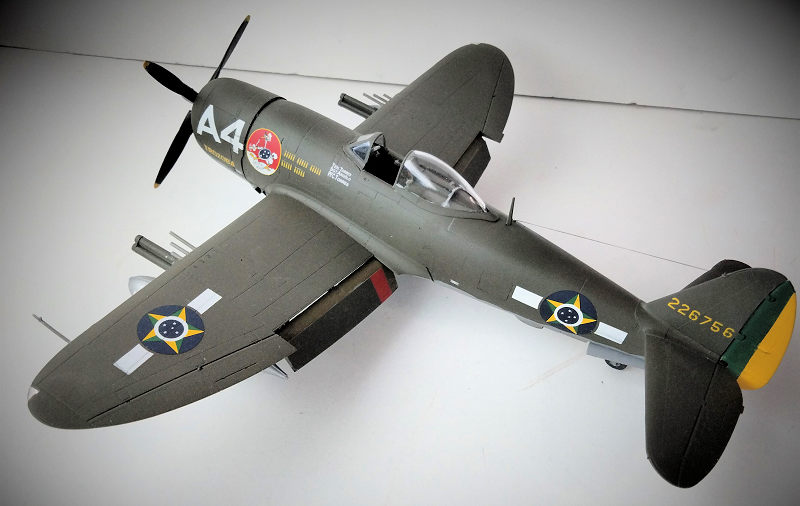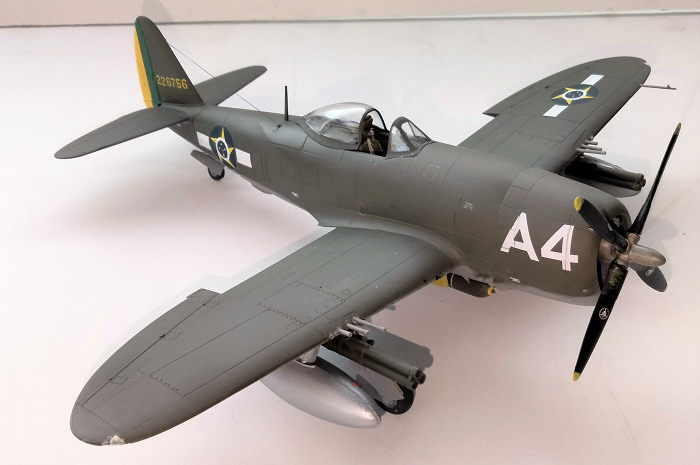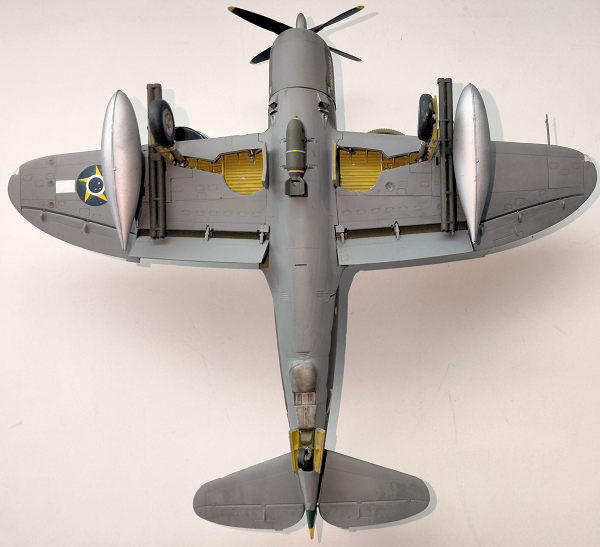
Tamiya 1/48 P-47D Thunderbolt
| KIT #: | |
| PRICE: | |
| DECALS: | |
| REVIEWER: | Mark Rossman |
| NOTES: | FCM 48020 decals |

| HISTORY |
The P-47 was an outstanding escort and ground attack aircraft and was the heaviest and largest single seat fighter built during WWII. It rose out of a humble beginning which saw its ancestors the P-35 and P-43 fall short of expectations.
Alexander Kartveli continued the lineage with the cream of the crop, the P-47. In 1939 Republic created two prototypes, one with an Allison liquid cooled engine, which turned out quite inadequate, underpowered and woefully short in high altitude performance.
fhe P-47-D-25 series is when the “Bubble-Top” appeared and the nickname “Jug” came about as it looked like a milk bottle. Others claim it to derive from “Juggernaut” as the P-47 swept through western and southern Europe till the defeat of Nazi Germany. At first the flight leads and group commanders received this type, however as the summer of ‘44’ wore on to fall, the heavy ground attack losses saw the -25, 26 and 27 become the main P-47 type.
Early on the “Jug” was used as an escort to the ETO heavies but was replaced as the P-51 came on-line; its best role was that of a ground attack aircraft both in the ETO, MTO, PTO and CBI theaters. P-47’s was used by the U.S., British, French, Mexican, Brazilian and Russian air forces.
BFS History
At the outbreak of WWII, the Brazilian ministry of Aeronautics was formed by politician and lawyer Joaquim Pedro Salgado Filho and Major Nero Moura a military engineer. From there the National Airforce was created, later becoming the FAB (Brazilian Air Force). August 26, 1942 Brazil declared war on the Axis forces after a series U-Boat attacks that sank 36 Brazilian merchant ships off their coast. A decree in December 1943, founded the 1st Fighter Aviation Group (1st GAvCa).
 Major Nero flew to Orlando to negotiate agreements with the U.S., this
allowed the FAB to begin training in Panama with the U.S. for maintenance.
Supply, armament, communication, intelligence and medical training. Members of
the 1st BFS began training in Orlando on the P-40. Adapting to U.S. standards at
the School of Tactics, the group moved to Panama, where Major Nero was promoted
to Lt. Colonel. The group so improved itself that it was independently given a
Panama Canal Zone Air Defense sector.
Major Nero flew to Orlando to negotiate agreements with the U.S., this
allowed the FAB to begin training in Panama with the U.S. for maintenance.
Supply, armament, communication, intelligence and medical training. Members of
the 1st BFS began training in Orlando on the P-40. Adapting to U.S. standards at
the School of Tactics, the group moved to Panama, where Major Nero was promoted
to Lt. Colonel. The group so improved itself that it was independently given a
Panama Canal Zone Air Defense sector.
The group returned to Suffolk County Airport, in June of 44, where they were given training on the P-47. After a hard training course, they were ready for action and landed in the Port of Livorno Italy on October 6, 1944, where they were given D-25 Thunderbolts from the USAAF warehouse. 350th FG, had the distinction of having 4 Fighter Squadrons assigned to it; 345th, 346th, 347th and the 1st BFS, flying out of Tarquinia Italy and in December of ‘44’ moving to Pisa San Giusto Italy for the rest of the war.
The 1st BFS received its call sign in the city of Tarquinia, ‘Jambock’. Unit was divided between four squadrons that were identified by a letter and a number. The groups were the Red squadron (by the letter A), the Yellow squadron (by the letter B), the Blue squadron (by the letter C) and the Green squadron (by the letter D); in February 1945, Yellow squadron ceased to exist because of the low number of pilots belonging to the group.
Pilots of the 1st BFS made attacks against refineries, bridges, railways, plants and warehouses, It also participated with the Brazilian Expeditionary Force providing support in battles, including the Battle of Monte Castello.
Between November 1944 and April 1945, 48 pilots of the 1st BFS carried out war missions, a total of 22 losses occurred; five of the pilots were killed by anti-aircraft fire, eight had their planes shot down and bailed out over enemy territory, six had to give up flying operations on medical orders, after suffering nervous breakdowns, and three died in flying accidents.
Pilots shot down and captured were imprisoned at the Nuremberg Concentration Camp and Stalag VII-A. The latter weren’t freed until units of George S. Patton arrived at Moosburg an der Isar.
The remains of the brave Brazilian airmen who lost their lives in Italy were buried in the Brazilian Cemetery at Pistoia. Subsequently they were taken to Brazil and they are now in the crypt of the Monument of Dead of the Second World War, in Avenida Beira Mar, in Rio de Janeiro
 The 1st BFS Emblem. (From the Decal Sheet)
The 1st BFS Emblem. (From the Decal Sheet)
“Ostrich and the Cap”. Departing Norfolk Virginia Wednesday 09/02/44, on the “Columbie”, ready to fight but missing a group badge. Captain Aviator Fortunato Camara de Oliveira, commander of Blue Squadron and an artist, designed the group badge on board the ship. Revealing it on arrival at Livorno Italy, the athletic figure of the Ostrich that never hid his head from danger.
The group motto: “Senta a Pua!” (“HIT ‘EM HARD”)
Recognition:
In 1986 the achievements of the 1st Fighter Aviation Group in the Italian Campaign were recognized. The 1st GAvCa became the third unit, that does not belong to the United States Armed Forces, to receive the Presidential Unit Citation, due to the important advances of the Brazilian hunting group in the campaign in Italy. In addition to the Brazilian unit, only two other foreign units received such an honor, both from the Royal Australian Air Force.
Aircraft:
Note: After the block number, Evansville aircraft were identified by the -RE suffix, while Farmingdale aircraft were given the -RA suffix. Aircraft: “A4” – ‘TROZOBA’, P-47D-25-RE, (SN- 42-26756) – Unknown Disposition, likely shipped back to Brazil. Unit: 1st BFS, 350thth FG, 12th AF, Pisa Italy, Spring 1945.
Pilot: Tenente Alberto Martins Torres; Commanded Yellow Flight (Escuadra Vermelha) from November 6, 1944 to May 1, 1945. Flying 99 sorties. Torres was flying Costal Patrols off Brazil in a Catalina. When on July 31,1943, VP-74’s PBM ‘74-P-7’ located a U-boat on the surface via radar. Torres Catalina dropped depth charges which sunk U-199, off of Rio de Janeiro.
| COLORS & MARKINGS |
Tamiya sprays: AS-6 Olive Drab, AS-7 USAAF Gray, TS-29 Semi-Gloss Black.
Tamiya Lacquer Paint: LP-8 Pure Yellow (Rudder)
tru-color paint: TCP-078 REA Green (Rudder)
| REFERENCES |
fcm Tarquinia Brazilian T-Bolts at War 48020.
12th Airforce (Air Forces Southern) website
P-47 Thunderbolt with the USAAF in the MTO, Asia and Pacific – SMI Library (Kagero)
Osprey Combat Aircraft #92 - P-47 Thunderbolt Units of the Twelfth Air Force by Jonathon Bernstein
Wikipedia – 1st Brazilian Fighter Squadron
2 December 2022
Copyright ModelingMadness.com.
All rights reserved. No reproductio in part or in whole without express
permission from the editor. If you would like your product reviewed fairly and fairly quickly, please contact the editor
or see other details in the
Note to
Contributors. Back to the Main Page
Back to the Review
Index Page
Back to the Previews Index Page